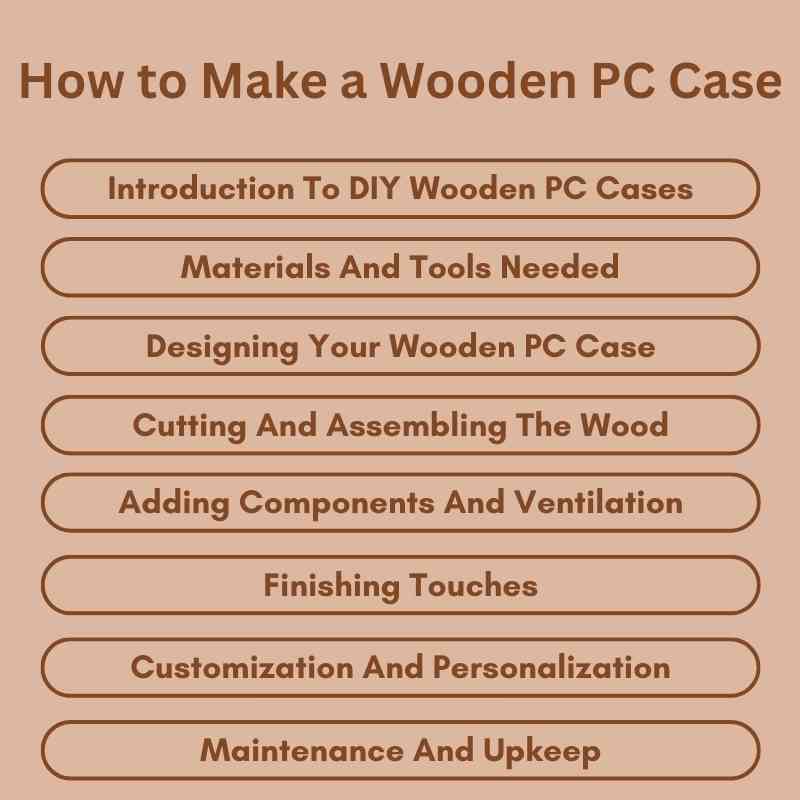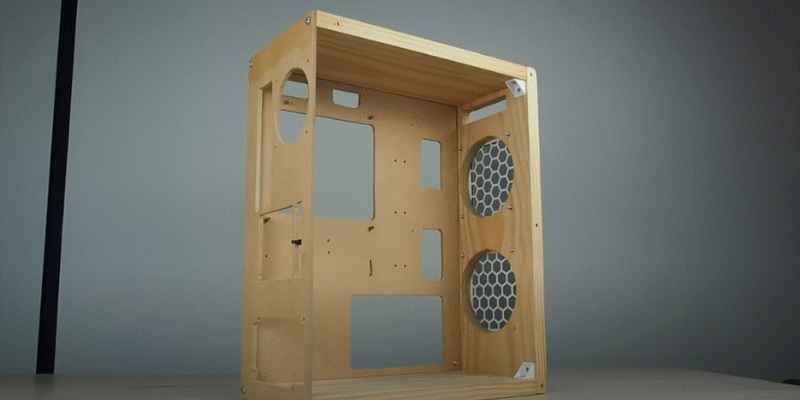To make a wooden PC case, start by designing a blueprint that fits your components. Then, cut and assemble the wood pieces according to your design.
Creating a wooden PC case combines functionality with aesthetics. A well-crafted wooden case can enhance your setup while providing excellent airflow and protection for your components. Choosing the right type of wood, like plywood or hardwood, ensures durability and style.
Proper planning and measurement are crucial for a successful build. Consider ventilation, cable management, and access to ports during the design phase. This project can be both rewarding and cost-effective, allowing you to customize your PC to match your personal style. With the right tools and materials, you can create a unique case that stands out.
Introduction To DIY Wooden PC Cases
Creating a wooden PC case offers unique charm and style. Custom designs let you showcase your personality. Wood provides a warmth that metal cases lack. Each wooden case is one-of-a-kind, making it special.
Benefits of a wooden design include better insulation and sound dampening. Wood absorbs noise, keeping your PC quieter. It is also eco-friendly, as wood is a natural resource. This choice can enhance your room’s aesthetic appeal.
Maintenance of a wooden case is simple. Regular dusting keeps it looking new. Using a clear coat protects it from scratches. Overall, a wooden PC case is a great choice for any enthusiast.

Materials And Tools Needed
Choosing the right wood is important for your PC case. Softwoods like pine are easy to work with. They are lightweight and affordable. Hardwoods like oak or maple are strong but more expensive.
Consider the wood’s finish. Some woods look great with stains, while others shine naturally. Think about how the wood will match your room.
Essential tools for this project include a saw, drill, and screwdriver. A measuring tape ensures all pieces fit perfectly. Sandpaper helps create a smooth surface.
A clamp holds pieces together while you work. Safety gear like gloves and goggles keeps you safe. Having the right tools makes the job easier and more fun!
Designing Your Wooden PC Case
Start by sketching your ideas on paper. This helps visualize the final design. Use a pencil for easy adjustments. Focus on size and shape to fit your PC components.
Next, calculate the dimensions for each part. Measure your motherboard, GPU, and other components. Ensure there is enough space for cables and airflow. Proper ventilation is key to keep your PC cool.
Consider adding fans or vents in your design. Proper airflow prevents overheating. Keep the case stylish while ensuring functionality. A well-designed case enhances both appearance and performance.
Cutting And Assembling The Wood
Before cutting wood, safety is very important. Always wear safety goggles and gloves. Use a dust mask to avoid inhaling particles.
Choose a well-ventilated area for your work. Make sure your tools are in good condition. Keep your work area clean and organized.
To cut wood, follow these steps:
| Step | Description |
|---|---|
| 1 | Measure and mark the wood carefully. |
| 2 | Use a saw for straight cuts. |
| 3 | Sand the edges until they are smooth. |
| 4 | Assemble the pieces with wood glue or screws. |
Adding Components And Ventilation
Mount the motherboard securely to the case using screws. Make sure it fits well. Place the CPU and RAM into their slots before mounting. Use the right tools for this task.
Next, install the power supply. Ensure all cables are routed properly. This helps keep the interior neat. Connect the graphics card in the designated slot.
For proper airflow, add fans to the case. Place them near the bottom for cool air intake. Ensure they face the right direction. This helps cool the components effectively.
Leave space between components for air to flow. Avoid overcrowding areas with wires. Using cable ties can help organize cables better.
Finishing Touches
Sanding is a crucial step for a smooth finish. Use different grits of sandpaper.
Start with a coarser grit, then move to finer ones. This helps remove any rough spots.
After sanding, clean the dust off the surface. A damp cloth works well for this.
Staining adds color and highlights the wood’s grain. Choose a stain that fits your style.
Apply the stain evenly with a brush. Let it sit for a few minutes before wiping excess off.
<pSealing protects the wood from damage. Use a clear sealant for a lasting shine.
Apply the sealant in thin layers. Allow each layer to dry completely before adding more.
“`</p
Customization And Personalization
Creating a custom wooden PC case allows for unique designs. Choose wood types like oak or pine for durability. Carve patterns or shapes into the wood for a personalized touch. Use stains or paints to match your style.
For LED lighting, consider adding strips inside the case. This gives a modern look. Use RGB lights to change colors easily. They can be controlled with a remote.
Other modifications can include fan placements for better cooling. Create cutouts for extra airflow. Installing a glass panel showcases the interior design.
| Modification | Description |
|---|---|
| LED Lighting | Add vibrant colors to enhance aesthetics. |
| Fan Placement | Improve cooling with strategic fan locations. |
| Glass Panel | Show off your components while keeping them protected. |
Maintenance And Upkeep
Regular cleaning and dusting keep your wooden PC case looking great. Use a soft, dry cloth to wipe surfaces. Avoid using water or harsh chemicals that can damage the wood.
Dust can settle in small crevices. A gentle brush or compressed air can help remove it. Make sure to clean around fans and ports for better airflow.
For wear and tear, check the case for any scratches or dents. Use wood polish or wax to restore its shine. A light sanding can fix deeper scratches.
Regular maintenance ensures a longer life for your wooden PC case. Keep it in a dry and cool place to prevent warping.

Frequently Asked Questions
How Do I Start Building A Wooden PC Case?
To start building a wooden PC case, gather your materials and tools. You will need quality wood, screws, and a power supply. Sketch a design that fits your components. Measure accurately before cutting to ensure everything fits snugly. Follow safety guidelines while using tools.
What Wood Is Best For A PC Case?
The best wood for a PC case includes plywood or MDF. Plywood is durable and lightweight, making it ideal for structure. MDF offers a smooth finish and is easy to work with. Choose wood based on your design needs and aesthetic preferences.
How Do I Cool A Wooden PC Case?
To cool a wooden PC case, ensure proper airflow. Incorporate intake and exhaust fans to maintain a consistent temperature. Use mesh panels for better ventilation. Monitor temperatures regularly to prevent overheating. Consider adding liquid cooling systems for high-performance builds.
What Tools Do I Need For A Wooden PC Case?
Essential tools for building a wooden PC case include a saw, drill, and screwdriver. A measuring tape ensures precise cuts. Sandpaper helps achieve a smooth finish. Additional tools like clamps and a router can enhance your build quality. Always prioritize safety while using power tools.
Conclusion
Creating a wooden PC case is a rewarding project. It allows for personal expression while protecting your components. By following the steps outlined, you can build a unique case that reflects your style. Embrace your creativity and enjoy the process.
Your custom wooden PC case will surely impress!

